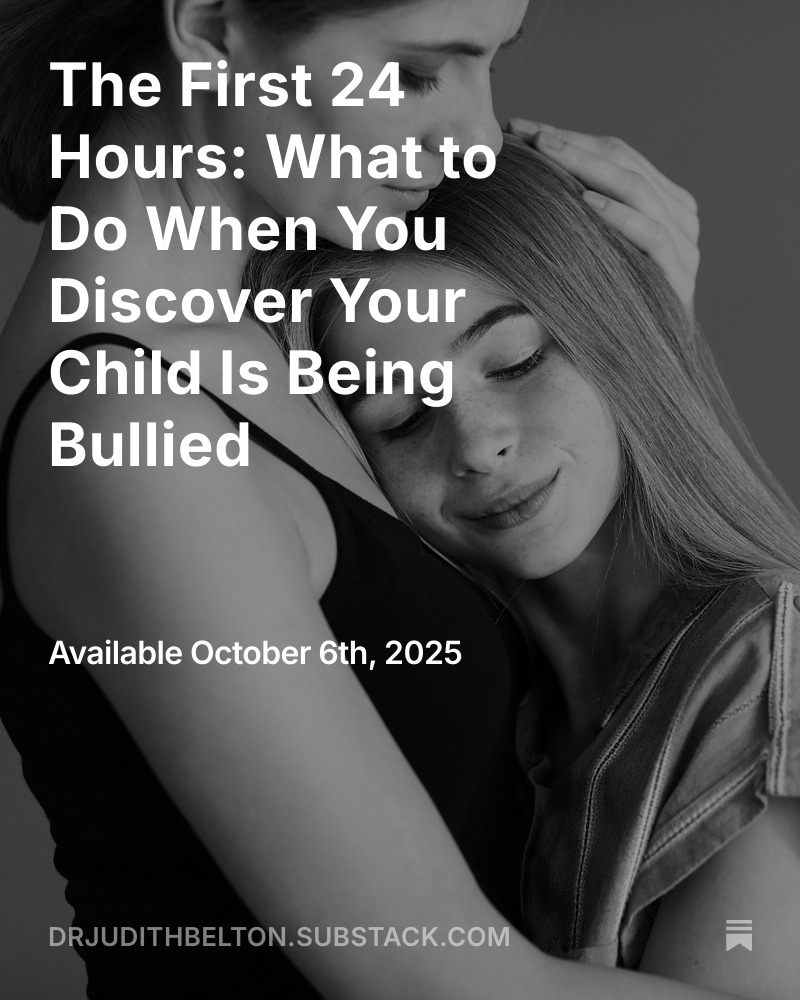A Parent's Guide to Responding When Your Child Is Bullied
When your child tells you they’re being bullied, every emotion floods in at once — anger, fear, heartbreak. Yet your first response shapes everything that follows. This article offers a grounded 24-hour action plan for parents: how to listen without judgment, document calmly, partner with schools, and rebuild safety through presence, not panic.
TEEN BULLYING
Dr. Judith Belton
10/6/20252 min read


Understanding Your Child's Experience
When your child confides in you that they are being bullied, a flood of emotions can overwhelm you. It’s natural to feel anger, fear, and heartbreak. However, how you respond in that moment is crucial. Your initial reaction sets the tone for the actions that will follow, and it's vital to approach the situation with a clear head and an open heart.
Listening Without Judgment
Take a deep breath and remember that your child is looking to you for support. Listening without judgment is the first step in creating an open line of communication. Validate their feelings and let them know that it’s okay to express their pain and confusion. Phrases like, 'I’m sorry this is happening to you,' can reassure them that they have a safe space to confide in. It’s also important to ask questions that encourage them to elaborate on their experience, all while remaining calm and composed.
Document and Collaborate Calmly
Once your child has shared their experience, calmly document everything they’ve told you. Keeping a clear record of incidents, including dates, times, and locations, is essential. This documentation will be valuable when you approach the school or other authorities. Partnering with your child's school is vital in addressing bullying. Make an appointment with their teacher or the school counselor to discuss the situation. Approach the discussion as a collaborative effort to ensure your child’s safety, rather than an accusatory confrontation.
Rebuilding Safety Through Presence
In the days following your child’s revelation, they may feel vulnerable. It’s important to provide a sense of security through your presence. Spend quality time together, engage in their preferred activities, and keep communication lines wide open. Let them know you’re there for support, advocating for their safety, without displaying panic or stress. Consistency in your reassurance can help them feel safe again.
Conclusion: Taking Action Together
Addressing bullying is a process that requires patience and understanding. The actions you take following your child's disclosure can make a profound difference. Listen actively, document incidents, collaborate with educational authorities, and prioritize emotional safety. By doing so, you empower your child to overcome bullying while reinforcing their trust in you as their protector and ally.
Read The Inside The Vault Article: The First 24 Hours: What to Do When You Discover Your Child Is Being Bullied
Do not forget the downloadable Parent Action and Reflection Sheet for this article.

Grief, Trauma Recovery, Bullying and Healing Support
Transformative experiences and insight integration for personal growth, removal of limiting beliefs and integrating your growth into your daily life
Integrys Insight Integration
Integrys Therapeutic Art Facilitator Training
drjbelton@artofintegration.life
+1-910-302-5515
© 2025. IATAV and Art of Integration. All rights reserved.
Where insight is developed through structured, guided conversations, reflection tools, and practices that help people map their inner world, recognize cognitive distortions, and reframe limiting beliefs.
